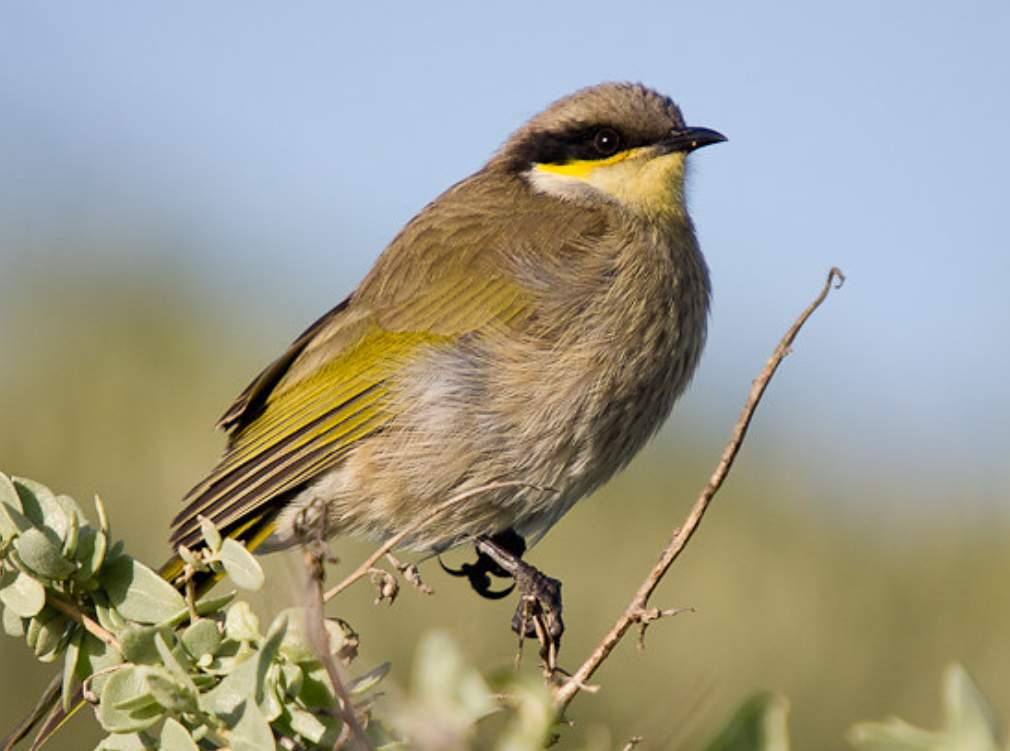Habitat: The singing honeyeater (Gavicalis virescens) is rarely seen near urban centers on the East Coast. The singing honeyeater is arguably Australia’s most widespread honeyeater, ranging across the continent west of the Great Dividing Range. Some reference texts claim that it also occurs in northern New Guinea, confusing it with a pale race of the Varied Honeyeater. Throughout its range, it frequents open scrubby shrubberies, whether in Mallee Mulgas or even coastal heaths.
Singing honeyeaters may wander in poor seasons but are usually sedentary in small enclaves of two to five or six birds that feed independently. Other birds, such as the brown honeyeater and red wattlebird, associate with them. Unlike many other birds, they cannot communicate with isolated birds of the same species, however. Furthermore, they are opportunistic nest predators, including the zebra finch; any nest with eggs or chicks left unattended is a potential food source for them. As a result, they are omnivorous birds.
Diet: Most of their foraging is done in shrubbery and low tree foliage. They switch between nectar, insects, and fruit as the opportunity offers. However, the birds also hop along the ground and steal eggs and young from finch nests. Insects taken include beetles, weevils, moths, caterpillars, wasps, ants, flies, and lerps. Honeyeaters also eat the fleshy fruits of more than 40 native shrub species, especially chenopods. The seeds are swallowed but not digested, so the birds act as dispersing agents.
Belying their name, Singing Honeyeaters are not accomplished singers but advertise territory in rollicking duets between pairs, usually from vantage perches on bushes. A variation of the song is trilled out sweetly in the dawn chorus. Pallid cuckoos often parasitize their nests.

Identification: Both adult sexes are similar. In drier areas, populations are paler; they are also greener in the southeast, browner in the southwest, and largest in Rottnest Island, WA. Upper parts brown, tinged olive; forehead and crown grey-brown; wings and tail brown with feathers edged olive-yellow.
The broad black band from the bill through the eye down to the side of the neck; a parallel yellow streak below, edged underneath with white broadening into a large patch on the side of the neck Underparts are off-white, streaked dusky gray, washed-browner over breast. Eyes brown. Bills black. Feet are dark gray-brown. The immature (as adults) face pattern and ventral streaking are much lighter.
Vocalizations: Singing honeyeater call is dry, whistled creeee in contact; soft, trilled prrit-prt-prrrit when alerted. The song is rollicking, rolling trilled crik-crikit-crik-crikit, and often in rattling duet.

Nesting and breeding: Nesting and breeding occur in February, following heavy rains. Nest is a cup of interwoven grass or bark strips, matted with cobwebs; 55 x 39 mm inside. The nest is lined with fibrous rootlets, sometimes fur or hair, suspended by a rim on the small branches of a bush or low tree, usually 0.5–5 meters above ground.
Eggs and Incubation: The singing honeyeater lays two or three eggs, pale pink or buff white, usually with a dark cap or band at the larger end; occasionally with a few small brown spots; oval, about 22 x 16 mm. Incubation: 12–15 days, female. Young fledge in 10–13 days. Often, two broods a season
Distribution: The singing honeyeater is found in pockets of shrubbery throughout inland woodlands west of the Great Dividing Range. It reaches the west and south coasts and penetrates regularly to the east only in central Queensland. Endemic; sedentary or nomadic in the desert.
Alternative Names: It is also known as Black-faced Honeyeater, Grey Peter, Grape Eater, or Forrest’s Honeyeater.
Size: The singing honeyeater is about 170-210 mm long.
Family: The bird is part of the honeyeater family, Meliphagidae.
Races: There are no races.
Read More: Varied honeyeater (Gavicalis versicolor)







